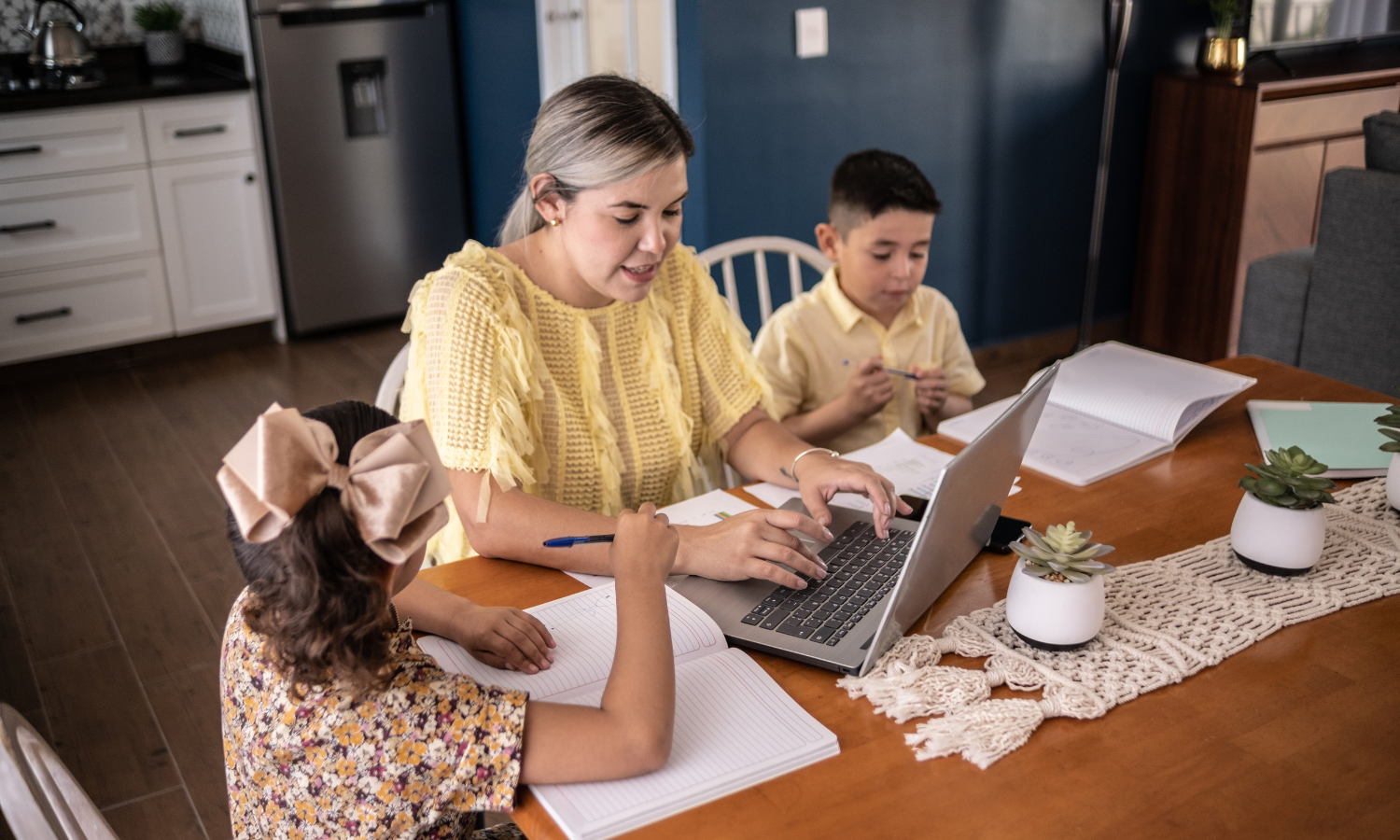By Angela Presner, MA, BCBA
This is a sponsored post from one of Autism New Jersey’s Partners, Interactive Kids.
Most New Jersey students are now a couple weeks into the school year. For many children on the autism spectrum, the start of a new classroom or school can still feel overwhelming. Families often wonder how to smooth the adjustment period, especially if challenges emerge after the first few days. The following strategies can help support your child’s comfort and success, no matter their level of need.
1. Connect with your child’s school team early and often

For some children, especially those who require substantial or very substantial support, repeated exposure helps build familiarity. And for children with specific needs, a tour can provide valuable insight: if your child has mobility challenges, you’ll see firsthand whether the school has appropriate accessibility features; if your child experiences light sensitivity, you’ll notice where the brighter or dimmer spaces are; and you may even get a peek into their current classroom to help them feel more at ease.
If a tour isn’t available, request a school map or create a simple visual aid that shows key locations like the classroom, cafeteria, and bathrooms.
Connecting with your child’s team regularly is also important. Teachers, case managers, and therapists are people too — building a relationship with them helps foster trust, collaboration, and a sense of partnership. When they know you and you know them, communication flows more easily, and it becomes much simpler to work together to support your child’s needs throughout the school year. And don’t forget—school secretaries often know the best way to connect with staff. If you’re having trouble reaching someone, the front office can be your best ally.
Parent-to-Parent Tip: Don’t feel like you’re bothering the team by sharing updates — it’s actually a huge help. Take it from me, a former special ed teacher: those little notes give staff the insight they need to better support your child that day. Think of it as teamwork, not “checking in too much.”
2. Utilize social stories, visuals, and other supports based on your child’s needs

Think about it this way: have you ever looked up a video of a vacation destination before you went? Travel itineraries or tour videos give you a preview so you feel more comfortable and prepared. Social stories serve the same purpose for kids — especially those who struggle with unpredictability — by letting them see what’s coming before it happens.
For a child who needs minimal support, short written stories may work best. For a child with limited verbal skills or who requires very substantial support, real-life photos and simple icons can be more effective. Regardless of the format, the key is finding the format that clicks for your child and keeps their attention. These tools allow children to rehearse situations in a safe, structured way before they experience them in real life.
Online resources like Teachers Pay Teachers or Canva templates make it easy to customize. And don’t forget — you can take photos of your own child’s classroom, teachers, or daily spaces to make the story even more personal and powerful.
Parent-to-Parent Tip: Don’t worry about perfect grammar or design when creating the social story—what matters is making it relatable to your child’s level of understanding. Sometimes the simplest, most familiar images are the ones that stick.
3. Practice real-life challenges in small, supported steps

At home, you can build comfort by practicing in short, playful bursts. Try working on a lock together, starting with a simple keyed lock if a combination lock feels overwhelming. Practice putting pencils in pencil cases. You can role-play moving from one “station” at home to another— like the kitchen table to the couch — to mimic the feeling of switching classes, or even practice carrying a tray during a pretend lunch line to get ready for the cafeteria. Some children may not change classes at all, but even within a single classroom, the expectation to move from group work to circle time or from the rug to their desk can feel just as challenging.
For children who require substantial or very substantial support, it helps to break tasks into smaller, easier-to-manage steps. You might add visuals that show each part of the routine, model the process yourself before asking them to try, or request simple modifications from the school—like leaving a few minutes early to avoid crowded hallways, or being allowed to eat lunch in a quieter space.
The goal isn’t perfection. It’s familiarity. Every time your child rehearses — even if they only complete one step of the bigger routine — it’s a win that builds their confidence.
Parent-to-Parent Tip: We know you’ve probably heard “take a break” before —but let’s be honest, as parents we don’t always follow it ourselves. Consider this your gentle reminder: practice in short bursts and celebrate small wins. If your child gets frustrated, step away and try again later. And whenever possible, try to laugh along the way — sometimes we parents struggle with combination locks too!
4. Finding the Right After-School Routine

Now that the year is underway, you’ll also start to hear about extracurricular opportunities—clubs, sports, or activities you may want your child to try or that teachers might recommend. Some of these happen right after school in the same building, while others may be at your child’s local school if they attend an out-of-district school placement. For others, it might mean an outside activity like music therapy or sports. And for many families, afternoons include in-home or out-of-home therapies such as ABA, speech, OT, or PT.
Remember, every one of these — whether staying late, going to another school, heading to an activity, or starting therapy — is a transition. That’s why it’s important to balance therapies, downtime, and extracurriculars —and to focus on what matters most. Sometimes added experiences are wonderful ways to build skills and friendships, but other times they can be too much on top of an already full day. Paying attention to your child’s energy level and mood will help you decide what to keep, what to pause, and where to protect time for rest. Stay ahead by becoming familiar with policies regarding absences for clubs and extracurriculars.
Parent-to-Parent Tip: It’s okay to experiment. Try one activity at a time, and don’t hesitate to step back if it feels overwhelming — finding the right balance often takes a little trial and error. And if social stories worked well for easing into the school day, try using them for new activities too, whether it’s a sports practice, therapy session, clubs, or spending time on the couch.
5. Support Peer Connections

Another idea is to ask your child’s teacher if you can come in and lead an activity your child enjoys — whether it’s a simple craft, a favorite story, or a game. This not only gives your child the comfort of sharing something familiar but also helps classmates see that they enjoy it too, building common ground and natural opportunities for connection.
If your child attends a group after school, there may be even more opportunities to connect. For example, if it’s a social skills group, you could write a short letter for the facilitator to share with other parents, letting them know you’re open to arranging a get-together with your kids outside of group time. If your child goes to an outside therapy, consider waiting in the lobby to see if other parents are around—you may be surprised at how many connections start with a simple hello. Some companies even start parenting groups for families whose children attend the same program. Why not? You’re all there for the same reason, and building those relationships can open doors to more social opportunities for your child.
Not a naturally social person? That’s okay. Try reaching out to another parent by email or connecting on social media. Building even a few of these relationships can help other parents better understand your child’s needs and strengths, while also creating new chances for them to socialize.
Parent-to-Parent Tip: Start small. Even ten minutes of a get-together, or a quick chat with another parent, can grow into meaningful connections that support your child’s social life over time.
As parents and caregivers, you can use these proactive strategies to help your child feel safe, understand expectations, know where to go and who to turn to, and manage challenges effectively. By laying a strong foundation from the beginning, you’re setting the stage for a successful and positive school year—for your child, their school team, and your family.
Angela Presner is the Cherry Hill School Team Supervisor for Interactive Kids, and a former special education teacher.









